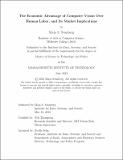| dc.description.abstract | With the emergence of Artificial Intelligence (A.I.), our lives and economy are under- going a profound transformation. While there are huge benefits to be realized by the technology, we must also prepare for shifting circumstances, including changes in mar- ket dynamics and the labor market. Thus, to inform policy, we need to understand and forecast the implementation of A.I.
Previous forecasts of A.I. proliferation have focused on the technical feasibility of replacing human labor in existing tasks. However, since the decision to deploy a technology is ultimately an economic one, I develop a framework that compares the cost of A.I. to the cost of worker compensation. As such, this approach considers not only technical feasibility, but also the economic advantage of A.I. over human labor.
Using the framework, I examine the case of Computer Vision in the U.S. non- farm economy, drawing on previous work on the cost of Computer Vision, as well as government data on wages, tasks, and the size of firms. The results suggest that while Computer Vision can replace human labor across sectors and industries, it will only have an economic advantage over human labor in the very largest enterprises. In smaller companies, the sum of task-specific employee compensation does not exceed system development costs. Data is identified as the main driver of total Computer Vision development costs, placing incumbent firms at an advantage in the race to realize the economies of scale that Computer Vision, and A.I. in general, enable.
Based on my findings and related work on labor markets, I argue that automation is not the only way in which the introduction of A.I. could harm workers. Increased market concentration, stemming from access to data being restricted to firms with existing operations as well as enhanced production efficiency, might cause a systemic power shift from workers to firms. I point to the facilitation of industry data-sharing as a tool for policy-makers to mitigate these effects by lowering the barriers to entry into A.I.-centric markets. | |
